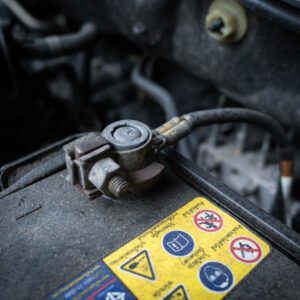A new battery can be quite pricey, which is why many drivers are now considering installing refurbished car batteries instead. But are these batteries safe to use? Let’s take a look at refurbished car batteries and their benefits and drawbacks.
Caution: Always wear eye protection whenever you’re working around any car battery.
What Are Refurbished Car Batteries?
As a battery ages, it begins to discharge in a chemical process called sulfation. Sulfate crystals start to form around the battery plates, and the battery begins to take longer to charge, retain less charge, and lose charge faster.
A refurbished car battery is an older car battery that has hopefully been de-sulfated to an extent.
Refurbishing a car battery, also known as reconditioning a car battery, clears away the sulfate crystals while also replenishing the battery’s electrolyte solution. This process rejuvenates the battery, returning it to peak efficiency. Refurbishing a car battery can be done at home, but you need some specialized tools, protective gear, and some household items like baking soda and epsom salt. It’s a time-consuming process that involves cleaning the battery terminals and battery cells, formulating a new battery cell solution, and replacing the old cell solution with the new cell solution. Refurbishing a battery can extend its lifespan past the usual three to five years.
Ultimately, if you aren’t confident in your DIY skills, it’s best to bring the discharged battery to a battery refurbishing store or leave the refurbishing to a trusted mechanic.
Benefits and Drawbacks of Refurbished Batteries
So if old batteries are as good as new ones once refurbished, why doesn’t everyone refurbish their old car batteries? Here are the benefits and drawbacks of refurbished batteries.
Benefits
First of all, a professionally refurbished car battery can last longer than a new battery in the long run. Refurbishing a battery means resetting the clock in a way. Instead of throwing out your car battery every time it dies, you can keep bringing it to a professional recharge station. As expected, this has a positive impact on the environment.
Refurbished car batteries are also cheaper than new batteries. Plus, if you have a more vintage vehicle, it might be easier to find a refurbished battery that fits instead of a brand-new one.
Drawbacks
Now for the drawbacks. While refurbished car batteries have longer lives overall, their lifespan between charges is shorter than the lifespan of a brand new battery. If you don’t buy from a trusted refurbishing store, you might also end up with a battery with a damaged casing. This is dangerous, as battery fluid can leak out of a damaged casing, leading to further car damage.
Should You Make or Use Refurbished Batteries?
The question of whether you should use refurbished batteries or not is a bit controversial. Some say the reduced environmental impact is worth it, while others claim that it’s too risky. There are a few situations when you absolutely should not refurbish a car battery, including the following examples:
- If you or the car battery refurbishing store doesn’t have the right tools
- When the battery’s already been refurbished or reconditioned three or more times
- When the battery’s damaged
Refurbishing a battery under these circumstances is simply not a good idea. Have a trusted battery refurbishing store refurbish your battery when it’s only able to retain 60% to 70% of its charge. They’ll be able to tell if the battery is salvageable or not.
In the end, it’s up to you whether or not you’re willing to use a refurbished battery. It will save you money and help reduce the environmental impact from car batteries. But these refurbished batteries do have their drawbacks. Be sure to only buy from a trusted refurbishing store so that the risks are much lower. Now that you know more about refurbished car batteries, you’ll be able to make an informed decision.
Any information provided on this Website is for informational purposes only and is not intended to replace consultation with a professional mechanic. The accuracy and timeliness of the information may change from the time of publication.





















